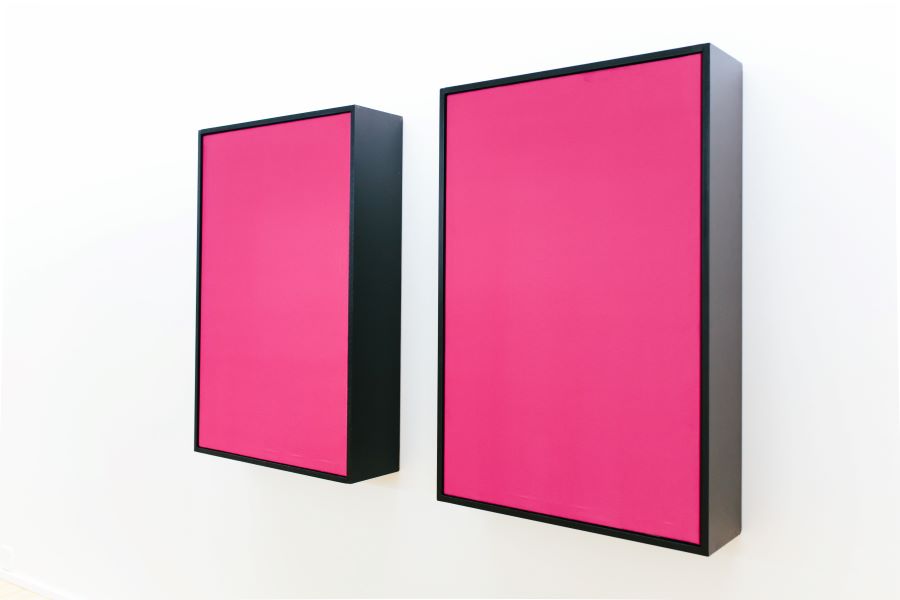Day treats sound as an essential means of examining the world.
Image: Julian DAY, Vibrant Matter (pink), 2016, installation view, Dominik Mersch Gallery. Photography by Matthew McGuigan. Courtesy the artist.
JULIAN DAY (VIC)
Julian Day is an artist whose work centres on sound. From performance, installation and sculpture to video, text and recorded audio, Day approaches sound as a form of social practice. “My work deploys sound’s material properties—its promiscuous spread, its relational intimacy—to reveal and examine hidden or overt power relations,” he explains.
Sound’s slippery ephemerality certainly provides a powerful foundation for Day’s destablising poetics and emancipatory politics. In works such as Moving Collective Ambience (2014), a community of performers forms a mobile ensemble in a public gallery space. Devoid of any sense of hierarchy, they cluster and clump together, largely indistinguishable from the audience until their voices start to swell and recede, creating a fluid soundscape comprised of comfortingly open crescendos and disquieting discordance. The performers enact a set of instructions and collectively create the work while also reducing the space between performer and audience. This is important to Day who, with his collaborators, creates beautiful, complex sound works that can often be performed by anyone. Moving Collective Ambience, for example, is open to participation by anyone who is interested. Auditions and musical credentials are cast aside in preference for an open and inclusive ‘opt-in’ approach.
Moving Collective Ambience is oneof a number of works created in Super Critical Mass, an ongoing collaborative project co-directed by Day. Formed in 2007, Super Critical Mass brings together temporary communities of performers from diverse backgrounds to explore the dynamics of public places, challenge traditional notions of performance and composition, and connect through sound, movement, proximity and time. From works for voice to those for single sets of instruments, Super Critical Mass resists the heterogeneity of the orchestra and instead focuses on homogenous sound, deploying a circular interdependent sound-making methodology grounded in a sense of emergence.
In sculptural works such as White Noise (2015) and Vibrant Matter (2016), the same sensitivity for dynamic ebb and flow is evident when sound is registered on a physical plane. Paper and loudspeakers transform the gallery space into a purring incubator of ambience. In White Noise, subsonic frequencies send ripples through reams of paper hung from the ceiling. Without warning, the paper shivers, convulses and then stops abruptly. In Vibrant Matter, totem-like black cubes house speakers that emit a steady frequency, recalling the sounds of helicopters and heartbeats.
Julian Day treats sound as an essential means of examining the world. In a world where art is a commodity that is protected and preserved by public institutions and the private market, sound provides an interesting avenue for alternative modes of engagement. “I am interested in how sound can address the problem of ‘the commons’—the spaces and materials held in common ownership,” Day says. Through the model of communitas—an unstructured, liminal state in which all members of a community share a common experience and are equal—Day uses sound to dissolve the usual boundaries of property and personal space. He experiments with the perimeters of a self-referential system through inversion, inclusion and disruption, and, in doing so, presents a collaborative, more equitable way of approaching art.
Jenna McKenzie is an Adelaide-based arts writer.
Julian Day holds a Bachelor of Music, Honours (composition) from Griffith University and a Masters of Fine Arts (sculpture, performance, installation) from the University of Sydney. Moving Collective Ambience is currently representing Australia at the California-Pacific Triennial, Orange County Museum of Art, USA.
Artist's website: julianday.com

